Key takeaways:
- Shadows create depth and emotional resonance in art and storytelling, transforming perceptions and enhancing viewer engagement.
- Understanding different types of shadows—including hard, soft, cast, and occlusion shadows—can significantly impact the mood and dimensionality of artwork.
- Mastering shadows involves practical exercises, observation, and feedback from others, alongside using the right tools and techniques to refine artistic skills.
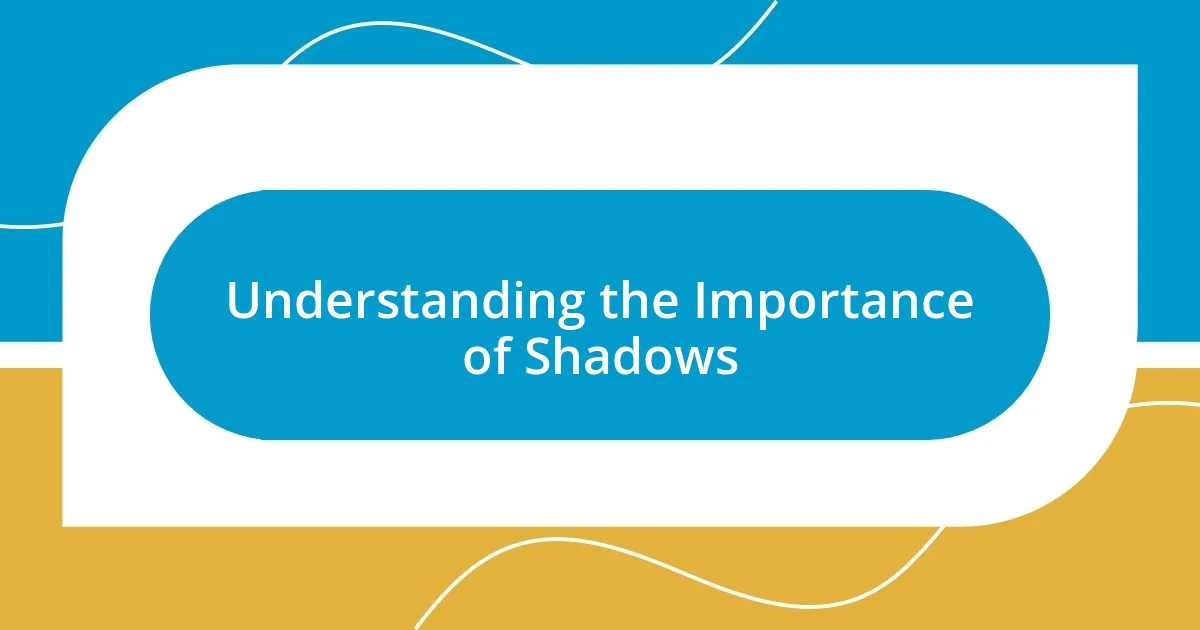
Understanding the Importance of Shadows
Shadows play a vital role in creating depth and dimension in any visual composition. I remember the first time I experimented with light and shadow in a photograph; the way I captured a fleeting moment of dusk, where the shadows danced across the ground, brought the image to life. Without those subtle variations, the scene would have felt flat, lacking the emotional weight that shadows can provide.
Have you ever noticed how shadows can completely transform our perception of a subject? I once attended an art exhibit where a simple sculpture appeared entirely different under varying light conditions. Some pieces looked inviting and warm with soft shadows, while others seemed cold and foreboding. This striking contrast made me realize that shadows are not just mere absence of light; they evoke feelings and provoke thoughts, shaping our overall experience.
Ultimately, understanding shadows enhances not only our visuals but also our storytelling capabilities. When I watch films, I often find myself captivated by how shadows deepen the narrative, reflecting inner emotions and conflicts. It’s fascinating to think about how a creative choice, like the placement of shadows, can guide the viewer’s emotions and enhance engagement. Isn’t it incredible how something as simple as a shadow can have such profound implications?
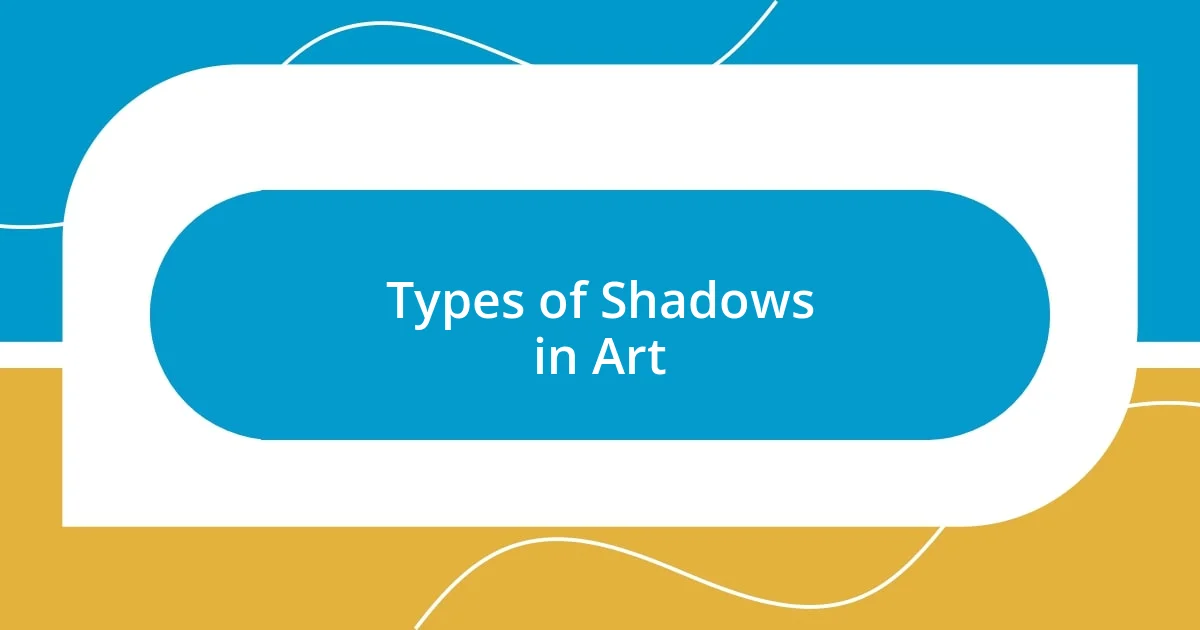
Types of Shadows in Art
Shadows can be categorized into several types, each conveying different moods and functions within art. In my own exploration, I’ve found that hard shadows create striking contrasts that amplify drama, while soft shadows evoke a gentle serenity. One of my favorite pieces I created involved a combination of both; the intense, angular shadows brought a sense of urgency, while the softer areas invited viewers to linger longer.
Another interesting type is cast shadows, which occur when an object completely blocks light, revealing its form and relationship to the environment. I recall the time I painted a scene using cast shadows to frame a vibrant figure in the foreground. The shadows not only defined the subject but also added a sense of context, anchoring the work in a specific atmosphere that resonated emotionally with my audience.
Then we have the occlusion shadows, which are the shadows that appear in the crevices and folds of objects where light struggles to reach. I remember experimenting with occlusion shadows during a life drawing class, where capturing the subtleties of these shadows completely transformed my sketches. It made me aware of the intricate nuances that shadows can reveal, granting my artwork a greater sense of realism and depth.
| Type of Shadow | Description |
|---|---|
| Hard Shadow | A strong, well-defined shadow that creates dramatic contrasts. |
| Soft Shadow | A gentle shadow that blends more seamlessly, evoking calmness. |
| Cast Shadow | Shadows formed by an object blocking light; adds dimensionality. |
| Occlusion Shadow | Shadows found in areas with limited light, emphasizing detail. |

Techniques to Create Depth
Creating depth in your art through shadow techniques is something I’ve come to really appreciate. One of my go-to methods is using layered shadows. I find that by adding multiple layers of shadow, I can steer the viewer’s gaze and enhance the dimensionality of my work. For instance, in a recent landscape painting, I layered shadows under trees and hills, which created a more immersive experience, drawing the viewer deeper into the scene.
To achieve depth, consider these effective techniques:
- Use gradients: Gradually transitioning from dark to light can create a natural sense of depth.
- Employ contrasting colors: Incorporate darker hues in shadowed areas and brighter tones in highlighted regions to add interest.
- Vary shadow lengths: Longer shadows can lend a dramatic touch, while shorter ones can suggest proximity to light sources.
- Experiment with opacity: Adjusting the opacity of your shadows can add layers, making them feel more dynamic and intricate.
- Incorporate perspective: Shadows can follow the lines of perspective, guiding the viewer’s eye through the artwork.
Another technique I often use is strategic placement of shadows. I think back to a portrait I painted where I deliberately positioned shadows to frame the subject’s face. The result was incredible; the shadows not only accentuated key features but also created a dialogue between light and dark. It made the subject come alive, as if they were stepping out of the canvas. This method can be transformative; when I see shadows thoughtfully placed, it often gives me a rush of excitement, knowing that I can manipulate perception in such a powerful way.
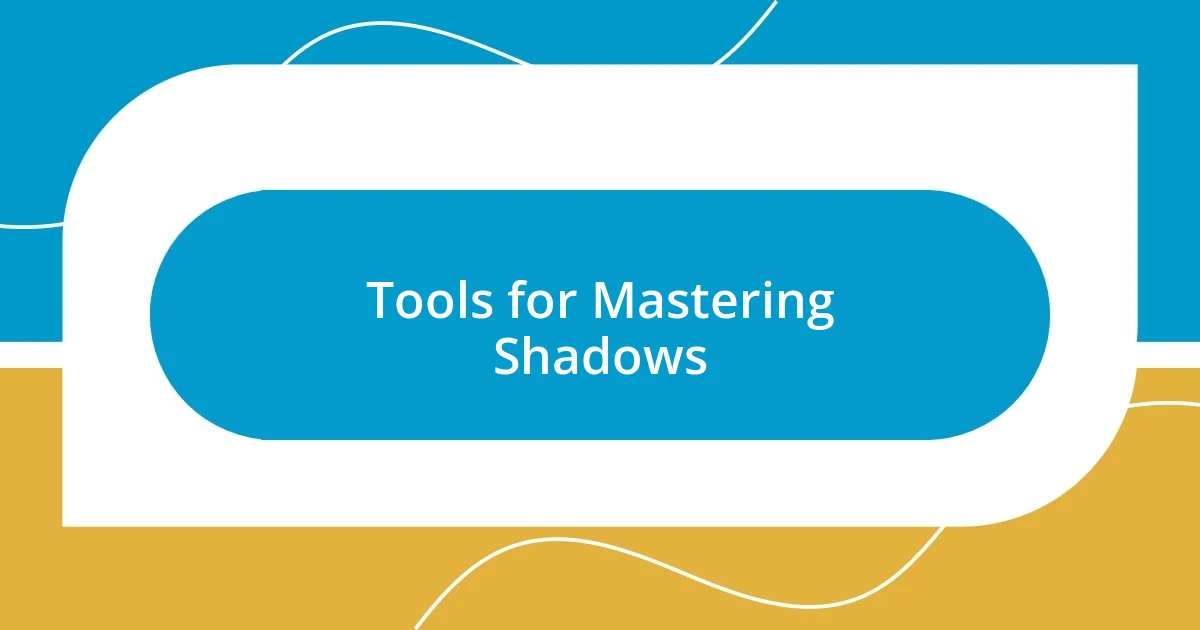
Tools for Mastering Shadows
To fully master the use of shadows, investing in the right tools can be a game-changer. I’ve always found that a good set of charcoal pencils helps to create rich, dark shades that bring shadows to life on paper. Their ability to blend allows for a seamless transition between light and dark, making it easy to add depth and dimension to my artwork. Have you ever noticed how the right tool can completely change your artistic expression?
For digital artists, software like Adobe Photoshop or Procreate is invaluable. These platforms offer powerful brush tools and layers, enabling a simulation of real-world shadows with precision. I remember a digital piece where I experimented with different opacities on separate layers—seeing the shadows take shape and interact in real time was exhilarating. The freedom to adjust and refine until I achieved the desired mood made every stroke feel intentional and impactful.
Don’t overlook the importance of basic traditional tools either. A simple blender or fingertip can create beautiful gradients when working with graphite or colored pencils. One time, I was sketching a quick study of a fruit bowl; the use of a blending tool turned a rough outline into something rich and textured. It made all the difference in conveying the shadows cast by the light source, reminding me just how vital it is to have the right tools at hand. What tools resonate with you?

Practical Exercises for Shadow Work
Engaging in practical exercises can really transform your skills in shadow work. One of my favorites is creating a shadow study from life. I often set up a still life with various objects and a strong light source, then spend time sketching the shadows they cast. This not only sharpens my observation skills but also helps me understand how light interacts with different forms, revealing the subtleties that can dramatically enhance my artwork. Have you ever just watched how shadows shift as the light changes? It’s mesmerizing!
Another exercise I recommend is the “shadow box” technique. I constructed a small diorama with various objects and experimented with angled lights to see how the shadows would play out on the surfaces around them. This approach not only adds a three-dimensional aspect to your understanding but also allows for creative experimentation. I felt a rush of excitement when I discovered new patterns and shapes formed by the shadows—it’s like finding a hidden layer of storytelling within my art.
Finally, consider the practice of nightly shadow journaling—this is a concept I came up with to engage more personally with shadows. Each evening, I take a moment to observe the shadows in my living space and jot down my impressions in a sketchbook. This routine has taught me to appreciate the emotional resonance of shadows, how they can evoke different moods, and the stories they tell when the day draws to a close. There’s something almost poetic about recognizing the fleeting dance of light and darkness, wouldn’t you agree?
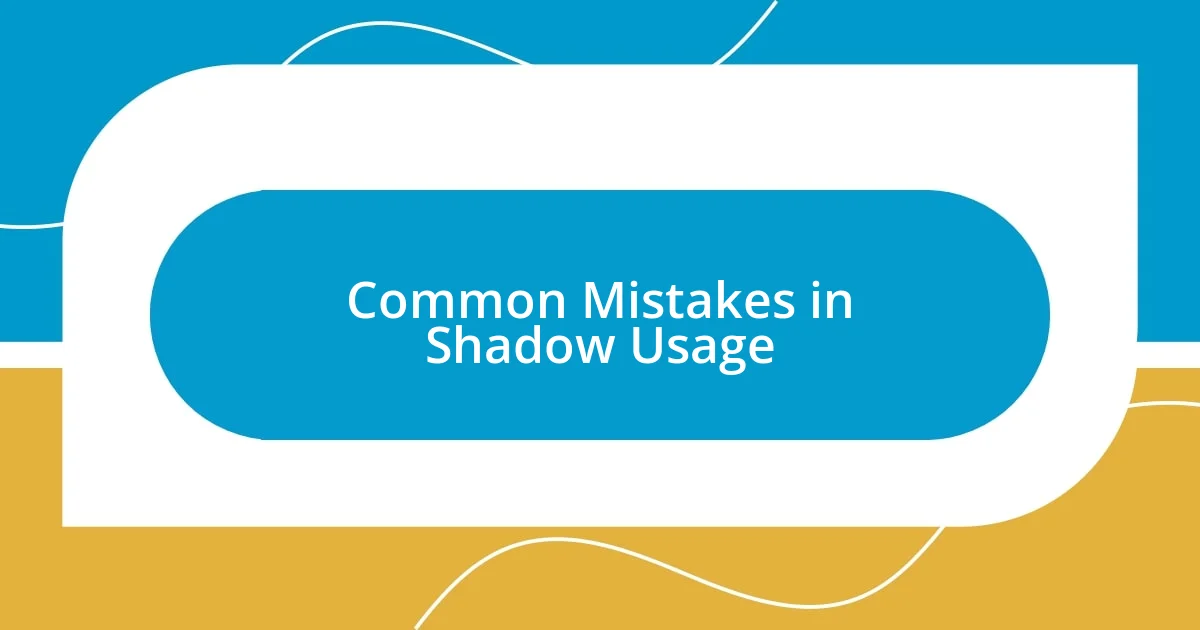
Common Mistakes in Shadow Usage
One common mistake I see often in shadow usage is neglecting the light source. When artists forget to consider where the light is coming from, shadows can end up looking disjointed or unrealistic. I remember trying to depict a strong sunset but placing shadows in all the wrong directions—it completely threw off the perspective and diminished the piece. Have you experienced a moment where your shadows just didn’t align? It can be frustrating, but it teaches you the importance of that foundational aspect.
Another misstep many make is over-exaggerating shadows. While drama in art can be captivating, applying too much darkness can overshadow the subject itself. I learned this the hard way during a watercolor landscape; I went heavy-handed with the shadows and lost the beauty of the vibrant colors beneath. Balance is key, don’t you think? It’s crucial to find a harmony between light and dark, where shadows enhance rather than diminish the focal point.
Finally, many artists struggle with understanding the texture and form of objects when adding shadows. For instance, I recall sketching a simple apple and giving it this flat shadow without considering how its roundness would affect the shape of the shadow. The lesson of recognizing how every surface interacts with light and shadow is invaluable. Shadows should speak of the object’s three-dimensionality rather than just be a dark blotch on the paper. What lessons have you learned through trial and error in your shadow journey?
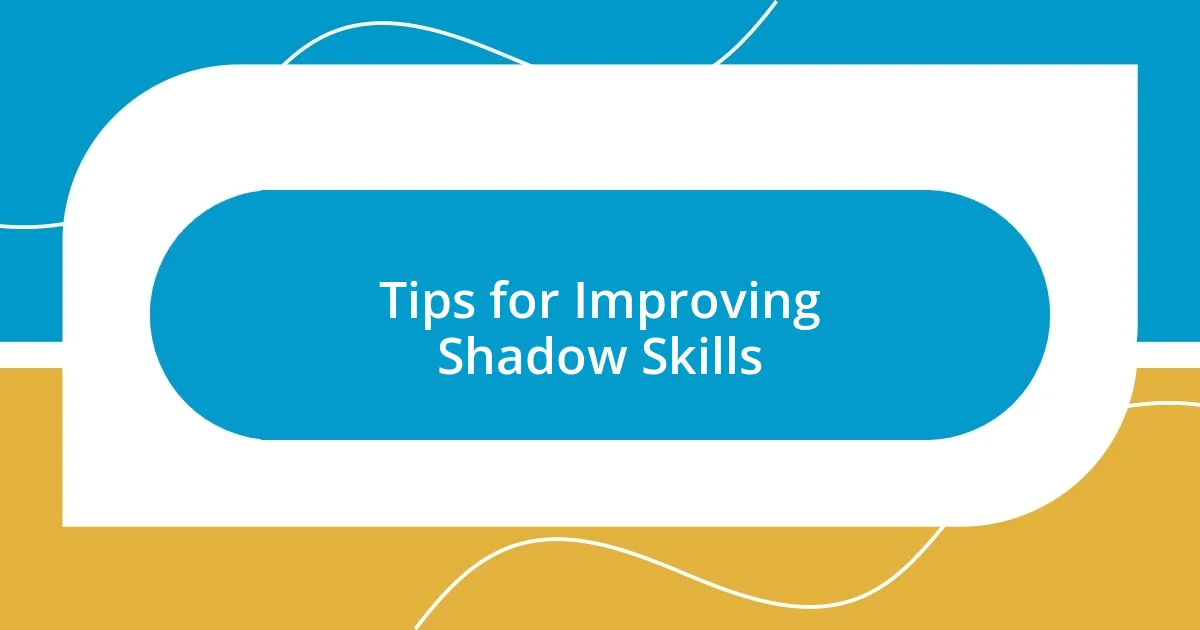
Tips for Improving Shadow Skills
One impactful tip I’ve picked up is the value of observation. Spending time outside, just watching how shadows dance with the daylight changes my understanding immensely. For instance, I once sat in the park at dusk, captivated by how the long shadows of trees stretched across the grass. Observing these fleeting moments reminds me that shadows are not static; they tell a story of time and space. Have you ever found yourself lost in such observations?
Another method that has transformed my shadow skills involves digital experimentation. I often use software to manipulate images, adding shadows and adjusting light sources to see how changes affect the overall composition. I remember one late night, as I tinkered with a digital landscape, I accidentally created a shadow that enhanced the entire scene. It was a happy accident that taught me how shadow dynamics can dramatically change a mood. Isn’t it fascinating how technology can enhance our artistic exploration?
Lastly, I emphasize the importance of feedback. Sharing your work with others can provide insights you might overlook. I regularly participate in art groups, where critique sessions often reveal how my shadows might be perceived by others. During one meeting, a fellow artist pointed out that my shadows often lacked warmth, which opened up a new perspective for me. Engaging with fellow creatives has been a rewarding experience, don’t you think? Learning from each other not only improves our skills but deepens our appreciation for the art form.












